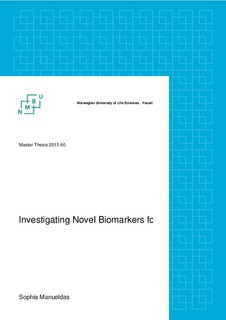| dc.contributor.author | Manueldas, Sophia | |
| dc.date.accessioned | 2015-07-31T08:56:36Z | |
| dc.date.available | 2015-07-31T08:56:36Z | |
| dc.date.copyright | 2015 | |
| dc.date.issued | 2015-07-31 | |
| dc.identifier.uri | http://hdl.handle.net/11250/294030 | |
| dc.description.abstract | Perinatal asphyxia is a condition in neonates with reduced oxygen (hypoxia) and/or reduced perfusion (ischemia). Today, we lack good biomarkers to measure the degree of oxidative damage caused by perinatal asphyxia. This thesis is about to testing and establishing two potential biomarkers for perinatal asphyxia: (a) random mutation capture assay (RMC) and (b) cell-free DNA (cfDNA). RMC is based on single molecule amplification and restriction digest to detect mitochondrial and nuclear mutations. Increased amount of cfDNA in circulating blood is found in patients with cancer, stroke and in premature infants.
The reaction spectrum of RMCs potential was tested by treating a fetale pig cell line, EFN-R, with different concentrations of H2O2 over different time intervals. The oxidative damage was monitored by RMC, in both the mitochondrial DNA (12S) and nuclear DNA (p53 gene). We observed an increased degree of DNA damage by oxidative stress substantially greater in nuclear DNA compared to mitochondrial DNA. Furthermore, antioxidant N-acetylcysteine amide (NACA) was investigated and identified as a significant protective agent against oxidative damages. To study the damage on expression level, RNA expression studies were performed for p53, Bax and Caspase 3 followed by protein expression studies for BAX.
To investigate cfDNA as biomarker for oxidative damage 80 newborn pigs, a model system very close to the human, were exposed to hypoxia and reoxygenation. A group of pigs was further treated with either NACA or hypothermia. Various extraction methods and standard curves for isolating cfDNA were tested and the concentration of cfDNA was measured by photometric and qRT-PCR methods (β-globulin). The concentration of cfDNA was highest 30 minutes after reoxygenation of hypoxia. The same tendency was observed by the photometric and qRT-PCR methods. However, no statistical significance was found. The thesis concludes that both RMC and cfDNA may be used as non-invasive biomarkers for assessing the degree of oxidative damage in newborns for perinatal asphyxia. | nb_NO |
| dc.language.iso | eng | nb_NO |
| dc.publisher | Norwegian University of Life Sciences, Ås | |
| dc.subject | Biomarker | nb_NO |
| dc.subject | Neonatal Asphyxia | nb_NO |
| dc.subject | Molecularbiology | nb_NO |
| dc.subject | Pediatric research | nb_NO |
| dc.title | Investigating novel biomarkers for neonatal asphyxia in newborn piglets | nb_NO |
| dc.title.alternative | Identifisering av potensielle biomarkører for neonatal asfyksi hos nyfødte griser | nb_NO |
| dc.type | Master thesis | nb_NO |
| dc.subject.nsi | VDP::Mathematics and natural science: 400::Basic biosciences: 470::Molecular biology: 473 | nb_NO |
| dc.subject.nsi | VDP::Medical disciplines: 700::Clinical medical disciplines: 750::Pediatrics: 760 | nb_NO |
| dc.source.pagenumber | 92 | nb_NO |
| dc.description.localcode | M-KB | nb_NO |
